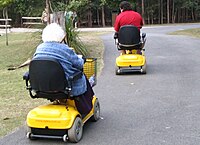
Photo from wikipedia
BACKGROUND Mobility limitations are the most common disability type among the 61 million Americans with disability. Studies of patients with mobility limitations suggest that inaccessible medical diagnostic equipment poses significant… Click to show full abstract
BACKGROUND Mobility limitations are the most common disability type among the 61 million Americans with disability. Studies of patients with mobility limitations suggest that inaccessible medical diagnostic equipment poses significant barriers to care. METHODS The study team surveyed randomly selected US physicians nationwide representing seven specialties about their reported use of accessible weight scales and exam tables/chairs when caring for patients with mobility limitations. A descriptive analysis of responses was performed, and multivariable logistic regression was used to examine associations between accessible equipment and participants' characteristics. RESULTS The 714 participants (survey response rate = 61.0%) were primarily male, White, and urban, and had practiced for 20 or more years. Among those reporting routinely recording patients' weights (n = 399), only 22.6% (standard error [SE] = 2.2) reported always or usually using accessible weight scales for patients with significant mobility limitations. To determine weights of patients with mobility limitations, 8.1% always, 24.3% usually, and 40.0% sometimes asked patients. Physicians practicing ≥ 20 years were much less likely than other physicians to use accessible weight scales: odds ratio (OR) = 0.51 (95% confidence interval [CI] = 0.26-0.99). Among participants seeing patients with significant mobility limitations (n = 584), only 40.3% (SE = 2.2) always or usually used accessible exam tables or chairs. Specialists were much more likely than primary care physicians to use accessible exam tables/chairs: OR = 1.96 (95% CI = 1.29-2.99). CONCLUSION More than 30 years after enactment of the Americans with Disabilities Act, most physicians surveyed do not use accessible equipment for routine care of patients with chronic significant mobility limitations.
Journal Title: Joint Commission journal on quality and patient safety
Year Published: 2021
Link to full text (if available)
Share on Social Media: Sign Up to like & get
recommendations!